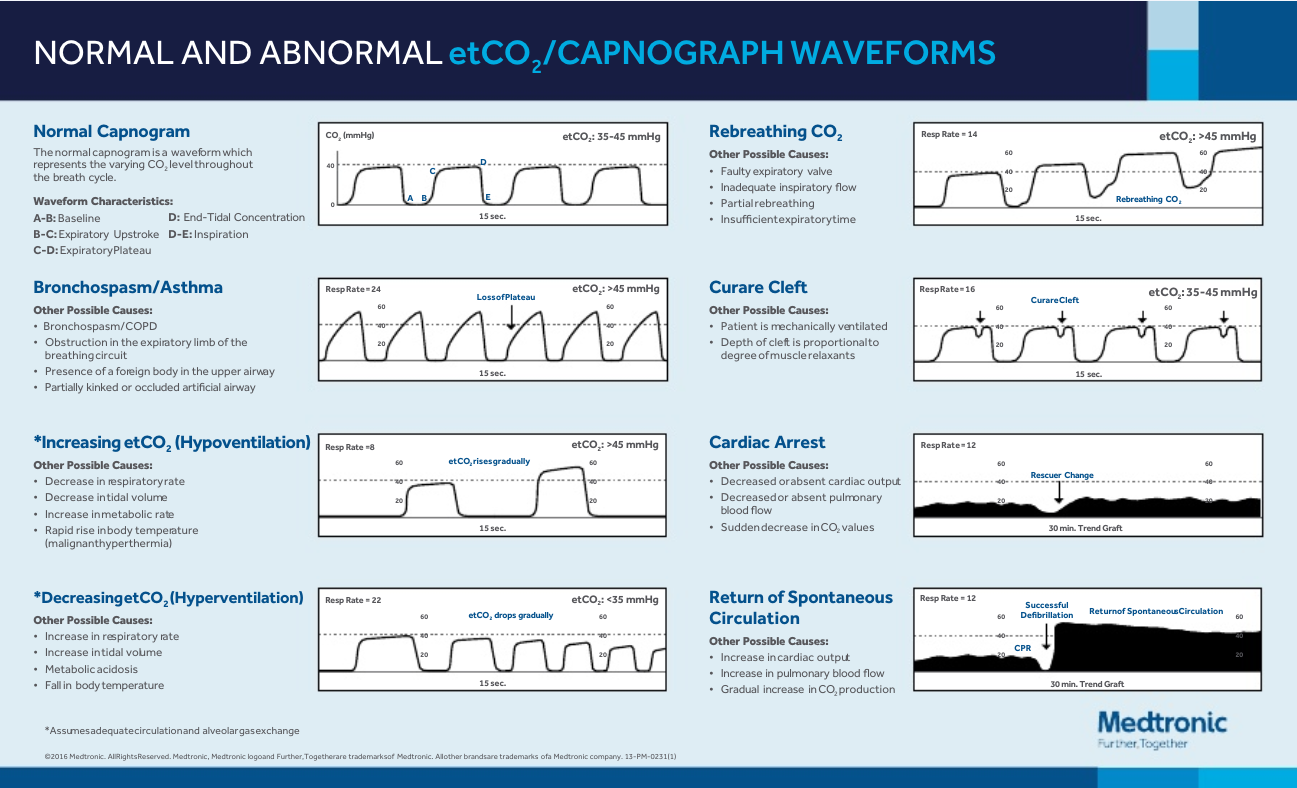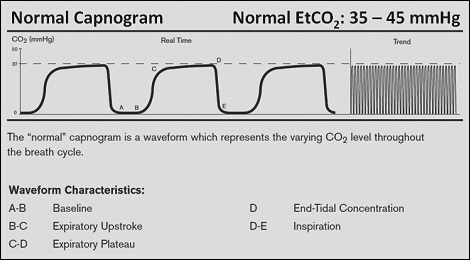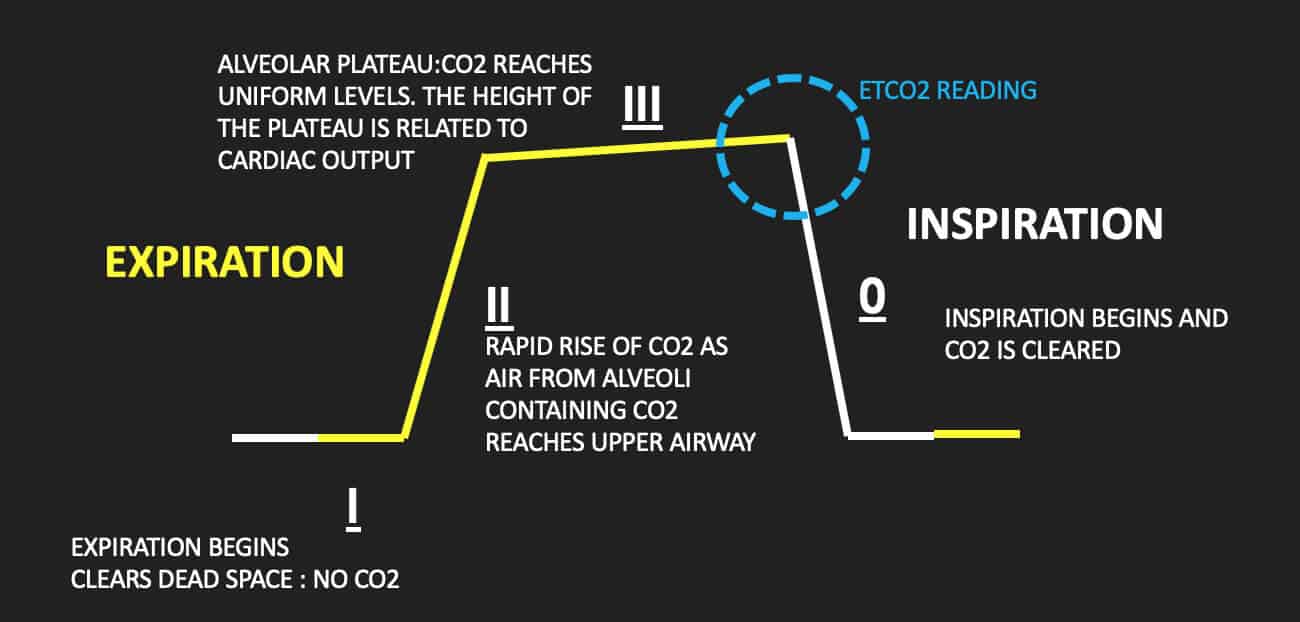normal end tidal co2 levels
Capnography waveforms etCO2 and breathing patterns Capnography can be used to measure end-tidal CO 2. Levels of end-tidal carbon dioxide are low despite normal respiratory rate in individuals with long COVID J Breath Res.

Figure 1 From Applications Of End Tidal Carbon Dioxide Etco2 Monitoring In Emergency Department A Narrative Review Semantic Scholar
Total pressure of a gas is the sum of the partial pressures of the gas Expired CO2 measured PetCO2 mmHg in waveform Percentage Normal Levels PaO2 85-100mmHg PaCO2 35-45mmHg Percentage vs.

. Variability of difference scores was not related to range of mean scores r 08 age r 09 or respiratory rate r 25. 2 to near normal normal EtCO 2 35-45 mmHg represents marked increase of CO 2 delivery to lungs suggesting ROSC If patient develops an organized rhythm after VFVTasystole check EtCO 2 to see if ROSC has occurred CONFIRM PLACEMENT OF ETT After intubation if ETCO 2 10mm Hg tube in trachea. MmHg Relate to the air we breath.
Monitoring of end-tidal carbon dioxide EtCO2 is a noninvasive method that measures the partial pressure or maximal concentration of carbon dioxide CO2 at the end of exhaled breath which is expressed as a percentage of CO2. Available evidence has established that ETCO2 measurement can provide an indication of cardiac output and pulmonary blood flow24 Non. Carbon dioxide is produced in the body as a by-product of metabolism and is eliminated by exhaling.
Levels of end-tidal carbon dioxide are low despite normal respiratory rate in individuals with long COVID. End tidal CO 2 monitoring is represented as a number and a graph on a monitor. So the short answer is you are right about the ranges 35-45 but that is for actual PaCo2 drawn from an ABG.
Measuring End Tidal CO2 Daltons Law. Usually end-tidal capnography is used by emergency physicians and paramedics to determine the respiration of the patient. The normal values are 5 to 6 CO2 which is equivalent to 35-45 mmHg.
Monitoring of end-tidal carbon dioxide EtCO2 is a noninvasive method that measures the partial pressure or maximal concentration of carbon dioxide CO2 at the end of exhaled breath which is expressed as a percentage of CO2. 35-40 mm Hg PETCO2 less than 10 indicates ineffective chest compressions. In patients with normal pulmonary function CO 2 normally 35 to 45 mm Hg and ETco 2 should correlate closely with a deviation of about 2 to 5 mm Hg.
Accuracy of end-tidal PCO2 measurements using a sidestream capnometer in infants and children ventilated with the Sechrist infant ventilator. 78 Nitrogen 21 Oxygen 1 CO2 and other gases Exhaled gases. After 20 minutes of CPR death occurs if ETCO2 is consistently below 10 mmHg with 100 sensitivity and specificity 15.
ETCO2 is a reliable indicator with a high prognostic value in determining the CPR outcome 11 12. Norm al EtCO2 levels 46 to 60 kPa signify adequate perfusion. Waveform and end -tidal carbon dioxide EtCO2 values.
Studies have shown that in patients who had ETCO2 of 10 mmHg or less cardiac arrest was associated with death 13 14. ETCO2 levels reflect the adequacy with which carbon dioxide CO2 is carried in the blood back to the lungs and exhaled. According to the book by Hockenberry and Wilson 2015 p 1140 normal values of ETCO2 are 30-43 mmHg which is slightly lower than arterial PaCO2 35-45mmHg.
End-tidal carbon dioxide ETCO2 is the level of carbon dioxide that is released at the end of an exhaled breath. Circulating blood CO 2 is slightly greater than exhaled CO 2 due to a ventilation-perfusion VQ mismatch. For a person with normal lungs the difference between end tidal and Paco2 can vary between 5-8mmHg depending on the book your reading.
The presence of a normal waveform denotes a patent airway and spontaneous breathing. This phase is also called a descending phase because oxygen fills when inhalation begins and CO2 concentration decreases. In normal conditions CO2 is 5 to 6 which is equivalent to 35-45 mmHg.
Hence CO 2 levels in the expired gas is a parameter that accurately reflects minute ventilation. Utility of end-tidal carbon dioxide detector during stabilization and transport of critically ill children. The number is called capnometry which is the partial pressure of CO 2 detected at the end of exhalation ranging between 35 - 45 mm Hg or 40 57 kPa.
When is end-tidal capnography recommended. Capnography can be used to assess unresponsive patients ranging from those are actively seizing to victims of chemical terrorism. End-tidal CO2 measured by an oralnasal cannula capnometry circuit is a noninvasive method of assessing indirect measurements of PCO2.
The waveform is called capnograph and shows how much CO 2 is present at each phase of the respiratory cycle. End-tidal CO2 EtCO2 monitoring is a noninvasive technique which measures the partial pressure or maximal concentration of carbon dioxide CO2 at the end of an exhaled breath which is expressed as a percentage of CO2 or mmHg. What Is A Normal End-tidal Co2.
In conditions of normal breathing 6 Lmin 12 breathsmin 500 ml for tidal volume etCO 2 is very close to alveolar CO2. 21 Hillier SC Badgwell JM Mcleod ME Creighton RE Lerman J. Normal end-tidal CO2 values are 35-45 mmHg.
The normal values are 5 to 6 CO2 which is equivalent to 35-45 mmHg. End-tidal CO2 EtCO2 monitoring is a noninvasive technique which measures the partial pressure or maximal concentration of carbon dioxide CO2 at the end of an exhaled breath which is expressed as a percentage of CO2 or mmHg. Continuous Waveform Capnograpy is written as PETCO2 which stands for patient end-tidal carbon dioxide.
In normal conditions CO2 is 5 to 6 which is equivalent to 35-45 mmHg.
The Normal Capnograph Waveform Deranged Physiology

Basic Capnography Interpretation Nuem Blog

Etco2 Valuable Vital Sign To Assess Perfusion The Airway Jedi

Exhaled Carbon Monoxide End Tidal Co2 And Peripheral Oxygen Saturation Download Table

Waveform Capnography In The Intubated Patient Emcrit Project

Normal And Abnormal Capnography Waveforms Infographic Capnoacademy Capnoacademy

Waveform Capnography In The Intubated Patient Emcrit Project

The Impact Of Ventilation Rate On End Tidal Carbon Dioxide Level During Manual Cardiopulmonary Resuscitation Resuscitation

Waveform Capnography In The Intubated Patient Emcrit Project

Capnography Provides Bigger Physiological Picture To Maximize Patient Care Jems Ems Emergency Medical Services Training Paramedic Emt News
Emdocs Net Emergency Medicine Educationcapnography In The Ed Emdocs Net Emergency Medicine Education
Riding The Wave Of Capnography Understanding Etco2 Vetbloom Blog
5 Medical Conditions Where Capnography Can Affect Bls Care Capnoacademy Capnoacademy

End Tidal Capnography Can Be Useful For Detecting Diabetic Ketoacidosis Monitoring Copd Acep Now

Exhaled Carbon Monoxide End Tidal Co2 And Peripheral Oxygen Saturation Download Table

End Tidal Co2 Monitoring In The Pre Hospital Environment More Than Just Endotracheal Tube Placement Confirmation Journal Of Paramedic Practice

Capnogram R Series Defibrillator Zoll Medical Uk

Average Etco2 Kpa During Cpr In Patients With Or Without Rosc Download Scientific Diagram
